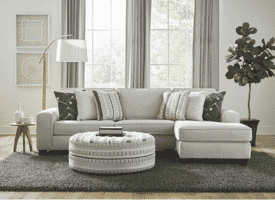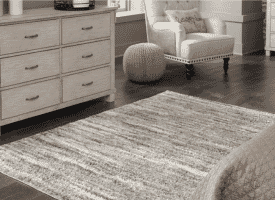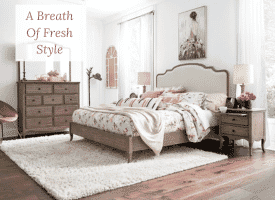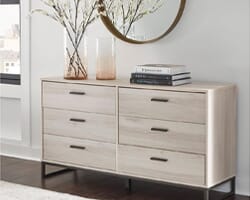|
|
Traditional furnishings tend to be symmetrical and formal, but they can be used to dress up a more casual environment. Traditional wood finishes are typically dark, cherry and mahogany for example. Updates to traditional style have brought lighter tones into the mix with finishes that resemble antique parchment. Fabrics that work well on traditional furnishings include chintz, jacquard, damask and brocade. Leather in rich brown tones can add an air of classic charm.
|
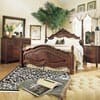 |
- Old World Estate:
- medium to dark finishes
- carved details with twists, fluting and ornaments such as acanthus leaves, flowers, fruit and claw and ball feet
|
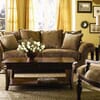 |
- Expeditionary:
- rich dark finishes
- fewer details and cleaner lines
- campaign furnishings
- touches of the tropics are incorporated with wicker, cane, bamboo and leather insets
|
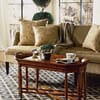 |
- American Heritage:
- medium to dark finishes
- painted finishes
- spindles, finials, classical motifs
|
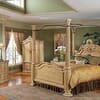 |
- Tuscan Villa:
- lighter finishes and earthy tones
- rich textures including terracotta, stone and metal
- sun-washed vineyards
|
Contemporary furnishings can run the gamut from stark Bauhaus minimalism to elegant Art Deco. Lines can be hard-edged or gently curving; finishes in all tones tend to be smooth and refined.
|
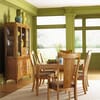 |
- Urban:
- flaring lines with little ornamentation
- range of finishes
- leather and microfiber
|
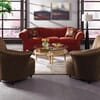 |
- Retro:
- whimsical with the kitschy flavor of 1950’s and 1960’s pop culture
- boomerang tables and space-age / Sputnik style
|
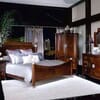 |
- Art Deco:
- streamlined lines
- traditionally light finishes and lacquer, today is updated with medium toned woods that show-off the grain
- mirrored and chromed surfaces
- mirrors, glass and acrylic
|
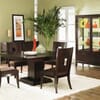 |
- Mid-Century Modern:
- form follows function
- rectilinear lines long and low to the ground
- organic and asymmetrical shapes
- little or no ornamentation
|
 |
- Casual Contemporary:
- rounded and eased edges
- medium oak finishes
- soft surfaces with pillow tops and pub backs on sofas
|
Coastal style, wherever it is found, is breezy and relaxed. Natural fibers are common on upholstery and floor coverings. Sea-themed prints are common on fabrics with images of seashells, tropical flowers and lighthouses. Finishes are light, weathered or painted. Palettes can be can be light and breezy with blues, greens and whites, or vibrant and tropical with reds, oranges and yellows added to the mix. Recent coastal style trends include seashell encrusted mirrors and tables and coral-form accessories and prints.
|
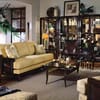 |
- California Coastal:
- relaxed sophistication with an eclectic blend of Old World European furnishings with dark finishes
- comfortable fabrics
- occasional touches of Asian style
|
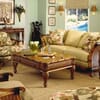 |
- Gulf Coast:
- wicker and rattan
- more vibrant colors and tropical influences
- modern flair in furnishings with touches of art deco lines and prints
|
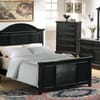 |
- Atlantic Seaboard:
- nautical themes
- lighthouses influence palettes with white, black, red, navy blue and yellow
- shutters and louvers
- traditional, American Colonial forms
|
Country style has many variations today, but most interpretations contain some common elements. Muted colors, mid-toned woods or painted finishes and vintage fabrics unite this category. A homespun quality is common with florals, checks, calicoes and stripes. Hand-made accessories, pottery and baskets add a homey touch.
|
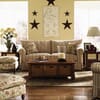 |
- American Country:
- down-to-earth practical style with a few spare frills
- aged patinas
- antique reproductions combined with primitives
- very homespun in character
- often patriotic in theme
|
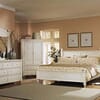 |
- Cottage:
- colorful variation of country with garden references
- dainty decorations
- bead board contrasting with wicker and iron furnishings
- weathered and aged finishes
- touches of whimsy
- overtly feminine
|
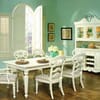 |
- French Provincial:
- medium-toned wood and painted finishes
- casual, but not without ornamentation
- ultimately livable in scale and treatment
- caned and rushed chairs
- relaxed, provincial interpretations of formal French style
- natural finishes and vibrant colors
- cane and rushed chair seats rather than heavy upholstery
- stone and terracotta accents and accessories
|
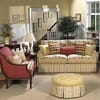 |
- English Country:
- Relaxed, comfortable interpretations of traditional English style
- Cheery, garden-inspired palettes
- more substantial than cottage style with the incorporation of heirloom furnishings and accessories
- feminine touches with delicate china and embroidered pillows
|
Americana styles are decidedly unfussy. Wood is appreciated for its inherent qualities, and finishes let the natural character show through. Palettes are muted, yet rich in tone. Fabrics are textured and comfortable, and combine well with leather. Forms are practical and unornamented but not lacking in substantial style.
|
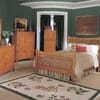 |
- Arts & Crafts / Mission Style:
- mid-toned finishes
- beauty in craftsmanship
- rectilinear forms with vertical slats
- mica lamp shades
- artisan-made accessories of ceramic, metal, and glass
|
 |
- Shaker:
- designed for efficiency
- beauty is found in usefulness
- unadorned and spare, but with elegant lines
- ladderback chairs
|
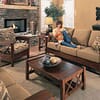 |
- Southwestern / Lodge / High Country:
- earth tones pervade in the natural colors of leather
- terracotta and light wood tones
- textiles have a rugged, hand-woven feel
- wall treatments are rough stucco and adobe
- iron and wood carvings used as accents
- Native American iconography and art forms
|
Oriental style has influenced western home furnishings for centuries. For example, the influences of Chinese designs can be found in the late work of Thomas Chippendale in the 18th century. Authentic oriental furnishings mix well with their occidental imitators, united by motifs and palettes.
|
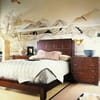 |
- Asian:
- Japanese and Chinese inspired interiors
- highly stylized forms
- mid-toned natural finishes and dark lacquer finishes
- silky brocades
- silk screens with painted screens and rice paper screens as room dividers
- inspiration from nature, mythical creatures and bamboo forms
|
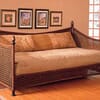 |
- Moroccan:
- jewel tones
- mosaics and colorful ceramics
- intricate patterns in textiles and ornately carved fretwork on wood furnishings
- layered oriental rugs
- gauzy fabrics
- an abundance of pillows
|
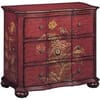 |
- Sub-Continental:
- paisley and other intricate prints
- textiles embellished with embroidery, sequins and small mirrors
- saturated colors in jewel tones and vibrant shades like pink and aqua
- kilim rugs
- Indian god figurines
- embossed, colored glass candle holders
|
Eclectic style is often unexpected, and sometimes daring, in its combinations of elements from different cultures, time periods and style categories. There are many variations within this category. Each projects a distinctive character. Good eclectic design is decidedly not just a hodgepodge of items. Furnishings are chosen with intention and attention to unifying design elements such as color, line, texture, mass and form. The use of collectibles is a common element of eclectic style, no matter the variety. While there are no hard and fast rules for eclectic style, several distinct trends in this approach have gained traction in interiors.
|
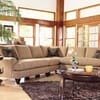 |
- Tribal Eclectic:
- strong elements of texture and pattern
- artifacts from Latin America, Africa, and Asia
- modern materials re-invented into tribal forms, like telephone wire used to make baskets
|
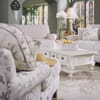 |
- Shabby Chic:
- white-washed furnishings
- tea-stained floral textiles
- slipcovers
- folk art objects
- flea market finds
- florals, stripes and patterns used in combination but with a unifying color palette
|
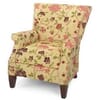 |
- Bohemian:
- European folk and gypsy emblems and antiques
- vibrant jewel-toned palettes, including ruby, orange, turquoise, purple and vibrant green.
- crystal chandeliers
- beading and fringe details
- exotic fabrics such as silk and velvet
- ruched, embroidered or otherwise embellished fabrics
|
